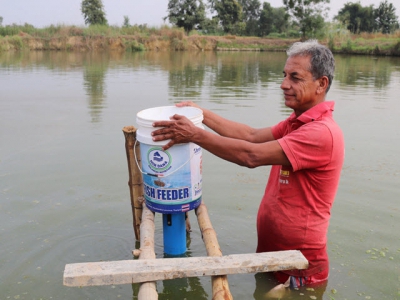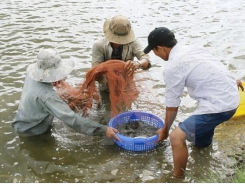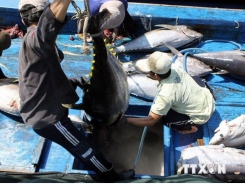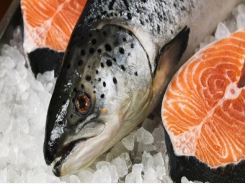Testing low-cost demand carp feeders in Nepal

Increased use can improve fish production, farmers’ livelihoods
Results of a study in Nepal using low-cost demand feeders for farmed carp production demonstrated the potential of this simple technology to help Nepalese fish farmers improve fish production and their livelihood.
Although aquaculture is a relatively new activity in Nepal, fisheries have long been a tradition for the country’s people. Over the past three decades there has been a significant increase in the production of fish, and the annual per capita fish consumption has increased significantly from 0.33 kg in 1982 to the current level of 2.93 kg. The Nepal Agriculture Perspective Plan has categorized fisheries and aquaculture in Nepal as a small but important and promising sub-sector of agriculture that contributes about 4.25 percent of the annual gross domestic product.
There is a perceived need to further develop aquaculture from the current, semi-intensive approach to a more commercial, intensive and diversified industry that’s more supportive of fish farmers through training and low-cost technologies. Currently, farmed fish production is inadequate at the pond level, mainly due to poor pond management practices, improper feeding, and the use of low-quality fry and fingerlings.
Other issues that affect fish farming activities in Nepal include the lack of proper feed pellet sizes suitable for different fish sizes and ages as well as the use of nutritionally deficient feed supplements and traditional, farm-made feed balls. And because of the traditional feeding practices used, not based on fish demand, aquafeed losses can be as high as 50 to 60 percent. Clearly, there is a need for better, on-demand feed management.
In Nepal, research on the use of low-cost, bucket-type demand feeders was recently started and is supported and promoted through a public-private partnership between the Shreenagar Agro Group, Winrock International, Tribhuvan University through its Institute of Agriculture & Animal Science, the Shree Kishan Innovation Hub and Smart Krishi.
This article reports the results of two recent tests using low-cost demand feeders carried out at the Institute of Agriculture & Animal Science research station of Tribhuvan University in Bhairahawa, Nepal, and at several fish farms in Chapia, Nepal. The research objectives were to assess the growth performance of carps (Mrigal or Naini carp, Cirrhinus mrigala, and common carp, Cyprinus carpio) and various water quality parameters under different conditions.
This research – based on simple and low-cost bucket demand fish feeder technology – is a positive start-up effort for collaborative research and to share improved production technologies among smaller farmers.

View of the experimental cages used in the test at the IAAS research station.
Test at the IAAS Research Station
In the test at the IAAS research station, there were five treatments with three replicates each, using nylon mesh, 1.75-by-1.45-by-1-meter cages placed in a pond and each stocked with 50 Naini/Mrigal fingerlings (8.93-9.16 gram average weight).
Treatments included type of aquafeed (sinking and floating) and type of feeding (traditional hand feeding; and locally made demand feeders using a pipe or a rod). The test lasted for 79 days and results showed no significant difference in stocking or harvest biomass of fish. However, the highest final average weight of fish (34.71 grams) resulted in the treatment with a pipe demand feeder and using the sinking feed.
There were no significant differences in the final feed conversion ratio (FCR) among the treatments; however, the best performance with the lowest FCR (0.837) resulted in the treatment using a pipe demand feeder and a floating feed, while the highest FCR (0.953) resulted from the control treatment using traditional hand feeding.
Regarding average daily growth rate (ADGR), there were no significant differences among the treatments, but the highest value (7.087 grams) resulted in the treatment with a pipe demand feeder and sinking feed and the lowest (2.980 grams) in the treatment with the rod demand feeder and floating feed. The highest ADG value (23 grams) was observed in the treatments with a pipe demand feeder and sinking feed and a pipe demand feeder and floating feed.
The treatment with a pipe demand feeder and sinking feed had the highest total feed fed with 1,453 kg, and the lowest the treatment with a rod demand feeder and floating feed with 1,247 kg. The highest feeding rate per fish resulted from the treatment with a pipe demand feeder and sinking feed with 96.91 grams, and the lowest in the treatment with a rod demand feeder and floating feed with 83.14 grams.

View of the pond at one of the farms where the demand feeders were tested.
Tests at Chapia fish farms
The demand feeders were also tested at eight fish farms in Chapia. At each farm, three treatments were used: control (traditional feeding), pipe demand feeder with sinking pelleted feed, and rod demand feeder with sinking pelleted feed.
The 3-by-3-by-1-meter experimental cages used were stocked at 100 fish per cage, and the fish species tested were also Mrigal/Naini carps or common carps depending on the different farmers. The initial total weight of the fish in the cages ranged from 1,576 to 1,891 kg, and the tests lasted 65 days.
Results showed that the final daily growth rate was higher (9.53 grams) in the treatment with rod demand feeders, but differences among treatments were not significant. Initial and final values for FCR and ADG were not significantly different, but values were higher in the treatment with rod demand feeders. There were no significant differences in the survival rates among the three treatments, although initial and final survival rates were higher (99.25 and 98.5 percent, respectively) for the rod demand feeder treatment.
The feeding rate per fish biomass was significantly higher in the control treatment versus the demand feeder treatments. The initial feeding rate per fish biomass was higher in the pipe demand feeder treatment (131.46 grams), but the final feeding rate was higher in the rod demand feeder (135.59 grams). The final total feed amount consumed per day was significantly higher than the initial feed amounts, but was not significantly different between the pipe and the rod demand feeder treatments.
Perspectives
Based on our test results, we believe that the increased use of demand-type (pipe or rod) feeders by Nepalese fish farmers will have positive effects on cultured fish production and will improve the farm productivity and livelihood of many fish farmers.
References available from first author.
Có thể bạn quan tâm
Phần mềm

Phối trộn thức ăn chăn nuôi

Pha dung dịch thủy canh

Định mức cho tôm ăn

Phối trộn phân bón NPK

Xác định tỷ lệ tôm sống

Chuyển đổi đơn vị phân bón

Xác định công suất sục khí

Chuyển đổi đơn vị tôm

Tính diện tích nhà kính

Tính thể tích ao hồ




 Mekong Delta urged to apply hi-tech in fish…
Mekong Delta urged to apply hi-tech in fish…  Gene expression response to sea lice in salmon…
Gene expression response to sea lice in salmon…